Heth: an artist at war
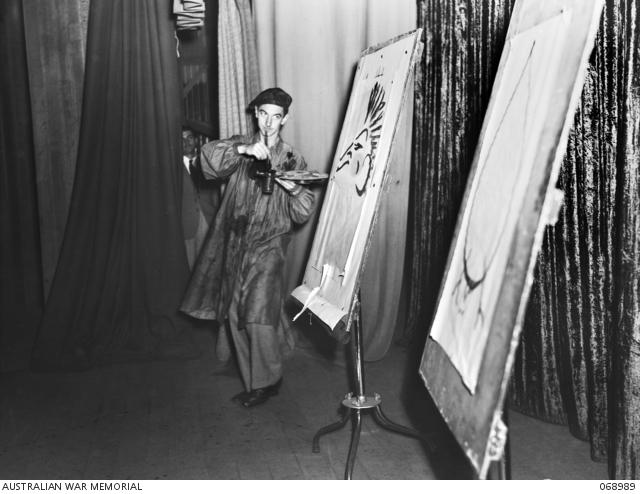
Portrait of Corporal Norman Hetherington performing his lightning sketch act during a concert in August 1944.
Norman Hetherington is best known as the man behind one of Australia’s most loved television characters, Mr Squiggle, but it was his service during the Second World War that first brought his drawings off the page and onto the stage.
For generations, “the man from the moon” was one of Australia’s most famous faces. With his fuzzy blue hair, wide child-like eyes, and signature pencil nose, Mr Squiggle delighted children and adults alike as he rocketed into the ABC studios, creating a sense of fun and wonder with his inquisitive nature and whimsical sketches.
Hetherington’s premise for Mr Squiggle was simple: children would send in their “squiggles” and Mr Squiggle would complete them, turning them into something recognisable by connecting the lines with his pencil nose. More often than not his sketches were penned upside down; when the drawing was finished he would cry, “Upside down! Upside down!” and his assistant would rotate the work to reveal the finished picture.
But before he made his name on television, Norman Hetherington served as a corporal during the Second World War.
“My father, like many people, didn’t like to talk about the war,” said his daughter, Rebecca Hetherington.
“When I was quite young, we were going through the attic space in our roof, and there were these numbers and letters written on a box. When I asked, ‘What’s that?’ he said, ‘That’s my infantry number,’ and I said, ‘When were you called up?’ And the look on his face. He turned to me and he said, ‘I was not called up, I enlisted.’ And that was really important to him.”
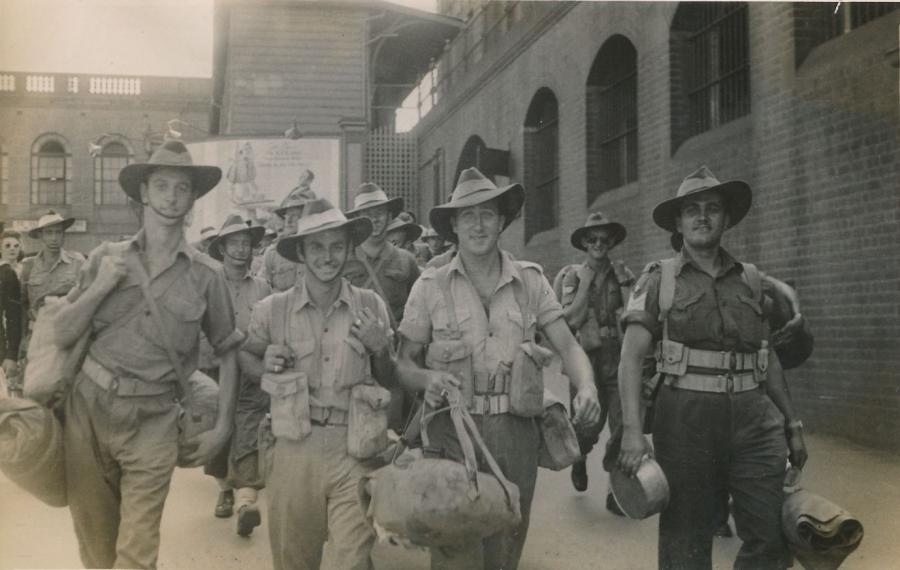
Norman Hetherington, left, arriving in Sydney in January 1945.
Photo: Rebecca Hetherington
Hetherington’s uncles had served during the First World War, and he was determined to do his bit for king and country when the Second World War broke out.
“He had a very revered uncle in the family – his father’s brother, Uncle John – who landed on Gallipoli,” Rebecca said. “He had a very intense war – he put his age up to enlist during the First World War and then put his age back down to join up during the Second World War – and so that sort of service was very ingrained in the family.”
Hetherington joined the Citizens Military Forces in 1941, and enlisted in the Second AIF in 1942 when he was 21.
“He enlisted in the infantry and fully expected that was the path his war service would take, but that all changed, and he apparently only had a week to get all of his things together,” Rebecca said.
“Literally weeks after enlisting, there was someone organising a performance for the troops in Sydney, and they asked him to perform. They knew he was a budding cartoonist and that he was able to draw on stage, and as a result of that, he was then moved across to the Army Entertainment Unit, Second Division Concert Party, which he said was later called the Number 4 Detachment of the 1st Australian Army Entertainment Unit.”
Hetherington went on to serve in Dutch New Guinea, New Guinea, New Britain, and the Torres Strait Islands, entertaining troops through acting, scriptwriting, costume and stage design, and the production of hundreds of pen and ink drawings outlining the life of the soldier.
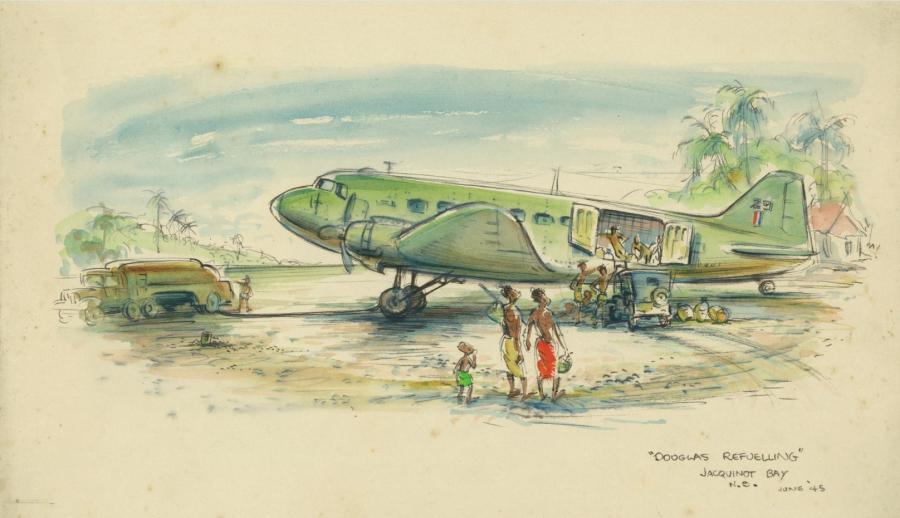
Norman Hetherington, Douglas Refuelling, Jacquinot Bay, N.B. June 1945.
Photo: Courtesy Rebecca Hetherington
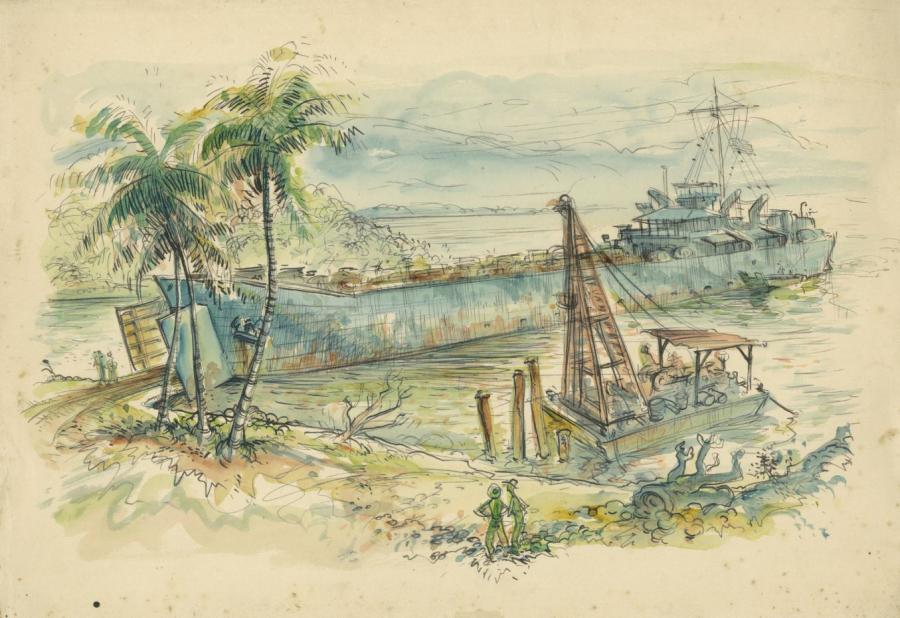
Norman Hetherington, Jacquinot Bay.
Photo: Courtesy Rebecca Hetherington
“It was obviously a really formative time in terms of his drawing and his art,” Rebecca said.
“He was able to keep painting and drawing and cartooning all the time, and there was a lot of artwork that he did during the war that I found when I was going through and cleaning up things and sorting out things in his studio after he died that I had never seen before.”
He also kept notes about where he went during the war and the work that he did.
“He had all of it written down, and when I put his notes down next to the artwork, I could see the progression of his travels around Australia and up into New Guinea,” she said.
“My father never threw anything out, so they were all in his studio where he worked, but just in drawers and folders.
“He had a little flip book of coloured paint pages that could be activated with a wet paintbrush and he would just paint wherever he went.
“There are scenic pictures and pictures of life in the army as well as the actual costumes and acts that were in the shows that his unit was doing.
“He would really personalise his performances so as they were setting up during the day, he would get out amongst the troops that they would be performing for during the evening and do quick caricatures of them that he would then present on stage that night.
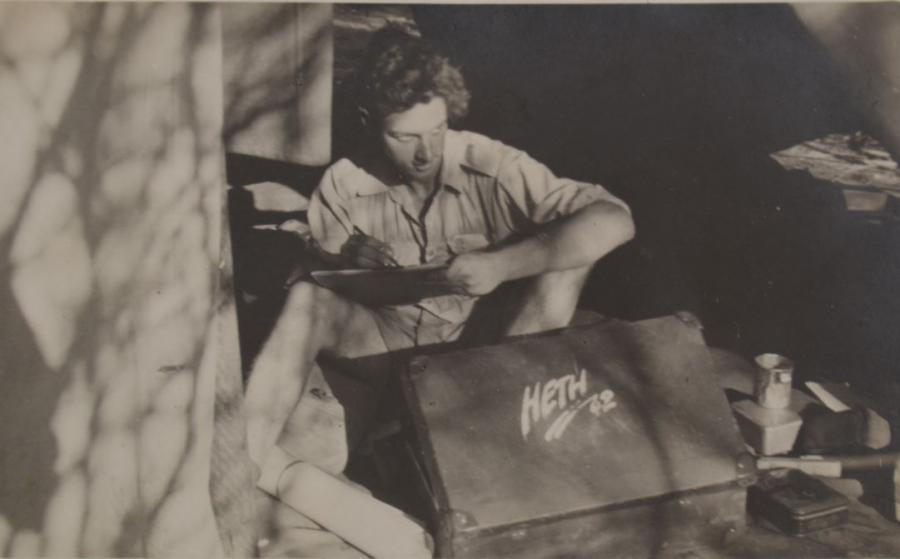
Norman Hetherington sketching in his army uniform with his art materials box in Western Australia. He signed his work as Heth.
Photo: Courtesy Rebecca Hetherington
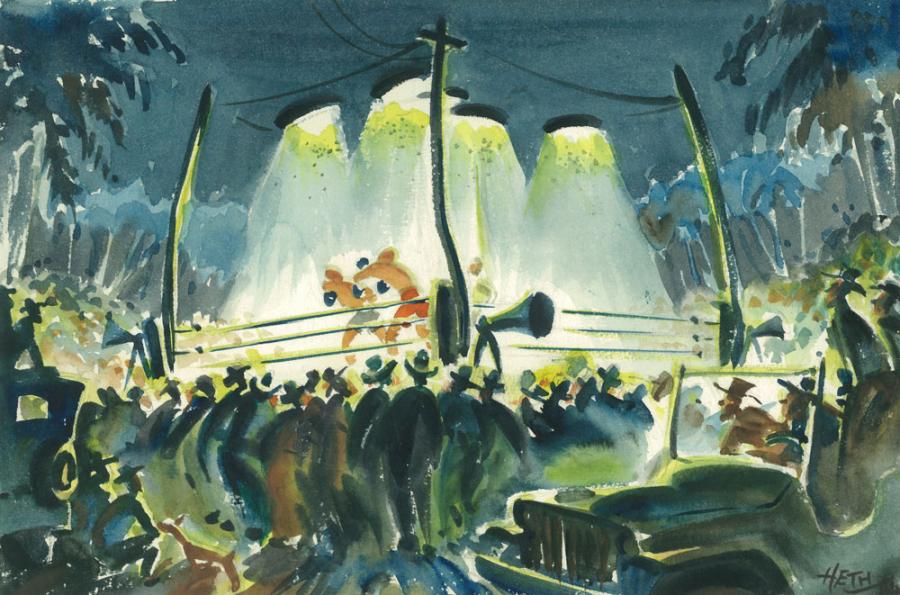
Norman Hetherington, Boxing Tournament, Merauke, Dutch New Guinea.
Photo: Courtesy Rebecca Hetherington
“At Rabaul, they brought the stage in on a barge, and they performed for the troops on the sand. There were hills all around them, and they weren’t sure who else was watching from the hills, and then they went back out on the barge.
“He also told a nice story about [the English actress, singer and comedienne] Gracie Fields and how she came up to entertain the troops. His unit had to perform the first half of the show for her.
“There were I think 10 performers, and 10 musicians in his unit, and a cook and an officer, but there were only two dressing rooms, so of course, she got one and they were all in the other one.
“Someone put a hibiscus in a jar in there for her, and he watched her perform from the side of the stage and did a lovely caricature of her which she signed for him.”
His performances during the war would have a major influence on his later work, including his moon-walking marionette, Mr Squiggle.
“When I started to really look at the work that he had from the war years, I realised that one of the elements of this lightning sketch act was that he would start with a few random lines and then he would turn it into something,” Rebecca said.
“He used this sort of easel that you could swivel, which we still have because he liked to use and reuse things. He would have two of them set up on stage, and he would paint something, and then he would turn it around, and it would be something else.
“It was funny because when I saw that, I thought, ‘Oh, my goodness me.’ Even back then, he was developing an element that he then brought into Squiggle 20 years later.”
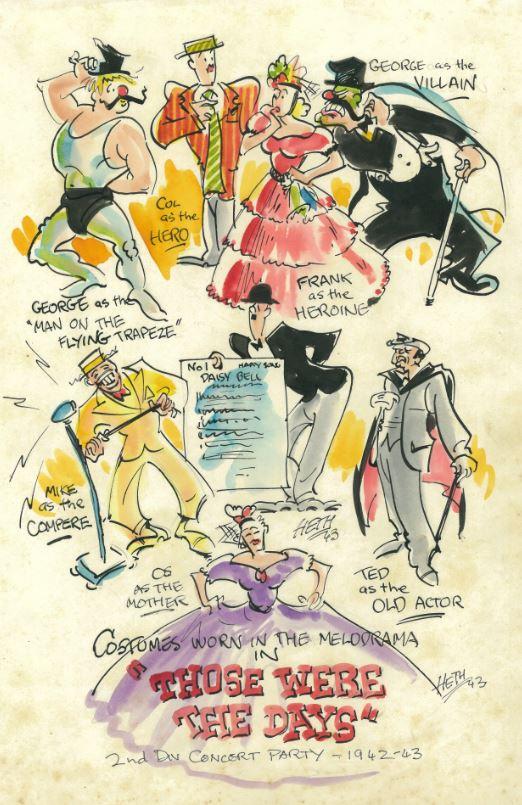
Norman Hetherington, 'Those were the days', 1943.
Photo: Courtesy Rebecca Hetherington
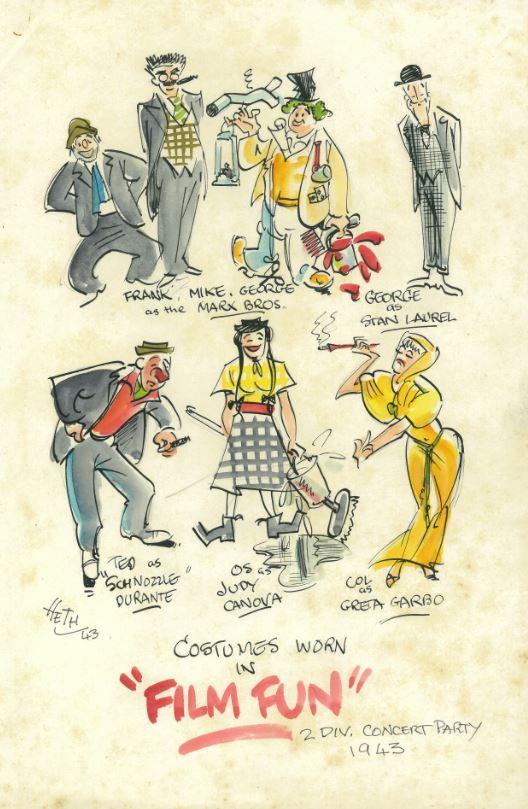
Norman Hetherington, 'Film Fun', 1943.
Photo: Courtesy Rebecca Hetherington
After the war, he established himself as a successful freelance cartoonist in Sydney and accepted a job at the Bulletin, where he worked alongside such artists as Norman Lindsay.
“As a child, he always wanted to be a cartoonist, and he always wanted to work at the Bulletin,” Rebecca said.
“He said to me once, ‘All I did at school was dream and draw,’ so he was really driven to draw to start with…
“That was always his focus, and as a 16-year-old he went to the Bulletin and introduced himself, and actually sold a cartoon.
“During his army years, he continued to sell cartoons to The Bulletin, and as soon as he came back from war – literally a week later – he was in the Bulletin office and they offered him a job as a staff cartoonist.
“And that’s when he started to explore the concept of puppetry.”
Her father had kept an article from Popular Science Monthly from the 1930s about making a puppet from an inner tube.
“He made the puppet after the war, and that got him started,” she said. “That was the era that he grew up in. You used and you reused. You didn’t throw things out. You kept them.
“Something could always turn into something else, and that’s certainly how he approached his puppet making, and that’s how he approached his artwork.”
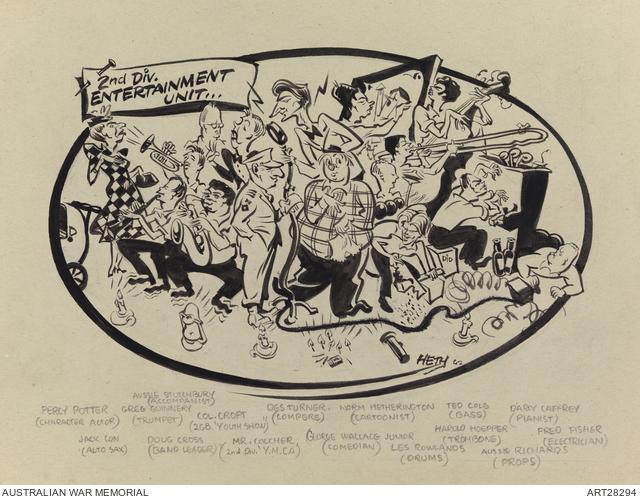
An illustration by Norman Hetherington showing the members of the 2nd Division Entertainment Unit. Their names and positions in the group have been inscribed in pencil.
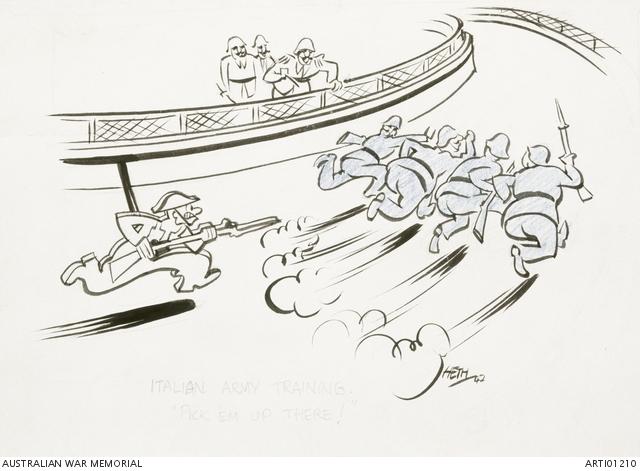
This cartoon by Norman Hetherington depicts four soldiers running around a racetrack to stay ahead of an mechanical soldier with bayonet. The caption reads: "Italian Army training. 'Pick 'em up there!'".
Hetherington continued to entertain people with his acting, writing and drawing at variety performances after the war.
“I think he was bitten by that bug in the army,” she said. “That was the first time that he ever really got up and performed, and he obviously enjoyed the banter with the audience.
“He then joined a group that was doing puppet shows around the place while he was working full-time at the Bulletin and started doing his own shows.”
He was asked to join the training school for the start of ABC TV and began his television career in 1956. Mr Squiggle first appeared on television on 1 July 1959 for what was meant to be a six-week adventure.
“He had a show on the ABC called Nicky and Noodle and the contract was coming to an end and the head of Young People’s and Light Entertainment said, ‘You should take a break with Nicky and Noodle, and work on some new scripts and new backdrops, but for the next six weeks, why don’t you bring in that puppet you were telling me about – the one that can draw.
“He literally had five to six days to work out Rocket and Blackboard and why Squiggle was going to come and land in the studios at the ABC – where did he come from, and how did he get there, and what he was going to draw on?
“They got such a fantastic response that poor Nicky and Noodle never made it back on camera.”
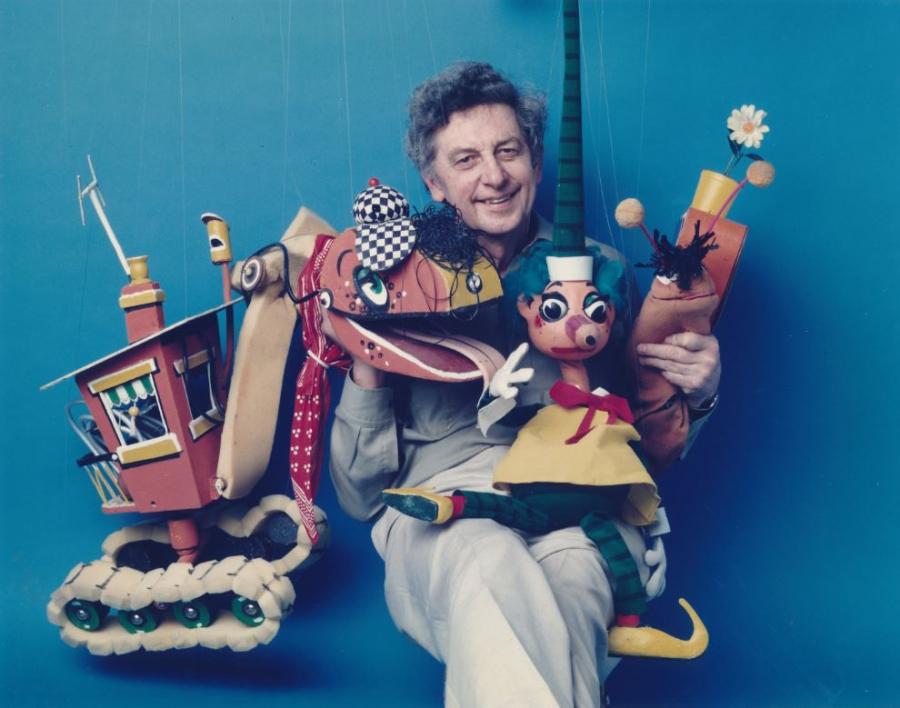
Norman Hetherington with Mr Squiggle and his friends Bill the Steam Shovel and Gus the Snail. The show proved so popular, it ran for 40 years.
Photo: Courtesy Rebecca Hetherington
Mr Squiggle and Blackboard – “Hurry Up!” – were soon joined on screen by Gus the Snail and Bill the Steam Shovel, and Mr Squiggle became a family show in every sense of the word. Hetherington voiced and made all the puppets, his wife Margaret, who he married in 1958, wrote the scripts, and his daughter Rebecca eventually presented the show with her from 1989 to 1999.
“I think Squiggle counted as his first born child really, and probably the favourite,” Rebecca said, laughing.
The show proved so popular, it ran for 40 years. The final episode aired on 9 July 1999 with Rebecca holding Mr Squiggle’s hand for the last time.
She said there was a little bit of her father in all of the puppets, but especially in Mr Squiggle.
“He expressed a lot of his inner child through Squiggle and that sense of wonder,” she said. “In a funny way my father was a bit like that; he was very practical, but he was just a little bit removed from the ugly side of the world like Mr Squiggle was.
“He was quite a shy person and he had impeccable manners. He was quite gentlemanly and very kind, and he had quite a social conscience about his fellow man.
“Anzac Day was a really important part of the year, and it became more and more important to him as he got older, and I would take him and help him get there, and he would join the other members of the entertainment unit and the people who he served with …
“Squiggle was really important to him, and I do think that Dad and Mr Squiggle kind of merged more as time went on, both in character and in physicality.
“Squiggle was a part of our family; he was a big force in our family life, and that’s the best way I can describe it.
“He loved every minute of it.”